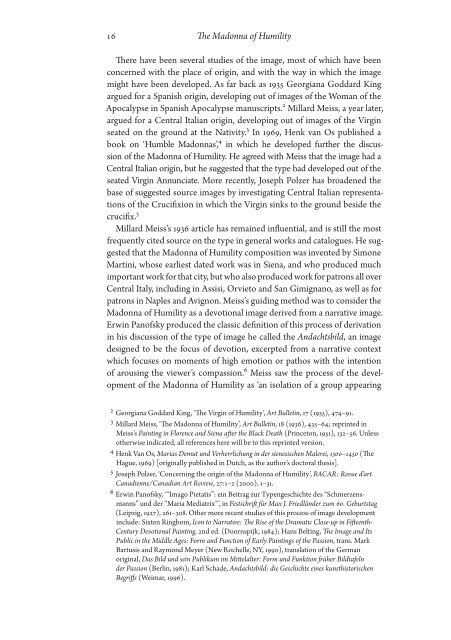The Madonna of Humility - Boydell & Brewer
The Madonna of Humility - Boydell & Brewer
The Madonna of Humility - Boydell & Brewer
You also want an ePaper? Increase the reach of your titles
YUMPU automatically turns print PDFs into web optimized ePapers that Google loves.
16<br />
<strong>The</strong> <strong>Madonna</strong> <strong>of</strong> <strong>Humility</strong><br />
<strong>The</strong>re have been several studies <strong>of</strong> the image, most <strong>of</strong> which have been<br />
concerned with the place <strong>of</strong> origin, and with the way in which the image<br />
might have been developed. As far back as 1935 Georgiana Goddard King<br />
argued for a Spanish origin, developing out <strong>of</strong> images <strong>of</strong> the Woman <strong>of</strong> the<br />
Apocalypse in Spanish Apocalypse manuscripts. 2 Millard Meiss, a year later,<br />
argued for a Central Italian origin, developing out <strong>of</strong> images <strong>of</strong> the Virgin<br />
seated on the ground at the Nativity. 3 In 1969, Henk van Os published a<br />
book on ‘Humble <strong>Madonna</strong>s’, 4 in which he developed further the discussion<br />
<strong>of</strong> the <strong>Madonna</strong> <strong>of</strong> <strong>Humility</strong>. He agreed with Meiss that the image had a<br />
Central Italian origin, but he suggested that the type had developed out <strong>of</strong> the<br />
seated Virgin Annunciate. More recently, Joseph Polzer has broadened the<br />
base <strong>of</strong> suggested source images by investigating Central Italian representations<br />
<strong>of</strong> the Crucifixion in which the Virgin sinks to the ground beside the<br />
crucifix. 5<br />
Millard Meiss’s 1936 article has remained influential, and is still the most<br />
frequently cited source on the type in general works and catalogues. He suggested<br />
that the <strong>Madonna</strong> <strong>of</strong> <strong>Humility</strong> composition was invented by Simone<br />
Martini, whose earliest dated work was in Siena, and who produced much<br />
important work for that city, but who also produced work for patrons all over<br />
Central Italy, including in Assisi, Orvieto and San Gimignano, as well as for<br />
patrons in Naples and Avignon. Meiss’s guiding method was to consider the<br />
<strong>Madonna</strong> <strong>of</strong> <strong>Humility</strong> as a devotional image derived from a narrative image.<br />
Erwin Pan<strong>of</strong>sky produced the classic definition <strong>of</strong> this process <strong>of</strong> derivation<br />
in his discussion <strong>of</strong> the type <strong>of</strong> image he called the Andachtsbild, an image<br />
designed to be the focus <strong>of</strong> devotion, excerpted from a narrative context<br />
which focuses on moments <strong>of</strong> high emotion or pathos with the intention<br />
<strong>of</strong> arousing the viewer’s compassion. 6 Meiss saw the process <strong>of</strong> the development<br />
<strong>of</strong> the <strong>Madonna</strong> <strong>of</strong> <strong>Humility</strong> as ‘an isolation <strong>of</strong> a group appearing<br />
2 Georgiana Goddard King, ‘<strong>The</strong> Virgin <strong>of</strong> <strong>Humility</strong>’, Art Bulletin, 17 (1935), 474–91.<br />
3 Millard Meiss, ‘<strong>The</strong> <strong>Madonna</strong> <strong>of</strong> <strong>Humility</strong>’, Art Bulletin, 18 (1936), 435–64; reprinted in<br />
Meiss’s Painting in Florence and Siena after the Black Death (Princeton, 1951), 132–56. Unless<br />
otherwise indicated, all references here will be to this reprinted version.<br />
4 Henk Van Os, Marias Demut und Verherrlichung in der sienesischen Malerei, 1300–1450 (<strong>The</strong><br />
Hague, 1969) [originally published in Dutch, as the author’s doctoral thesis].<br />
5 Joseph Polzer, ‘Concerning the origin <strong>of</strong> the <strong>Madonna</strong> <strong>of</strong> <strong>Humility</strong>’, RACAR: Revue d’art<br />
Canadienne/Canadian Art Review, 27:1–2 (2000), 1–31.<br />
6 Erwin Pan<strong>of</strong>sky, ‘ “Imago Pietatis”: ein Beitrag zur Typengeschichte des “Schmerzensmanns”<br />
und der “Maria Mediatrix” ’, in Festschrift für Max J. Friedländer zum 60. Geburtstag<br />
(Leipzig, 1927), 261–308. Other more recent studies <strong>of</strong> this process <strong>of</strong> image development<br />
include: Sixten Ringbom, Icon to Narrative: <strong>The</strong> Rise <strong>of</strong> the Dramatic Close-up in Fifteenth-<br />
Century Devotional Painting, 2nd ed. (Doornspijk, 1984); Hans Belting, <strong>The</strong> Image and Its<br />
Public in the Middle Ages: Form and Function <strong>of</strong> Early Paintings <strong>of</strong> the Passion, trans. Mark<br />
Bartusis and Raymond Meyer (New Rochelle, NY, 1990), translation <strong>of</strong> the German<br />
original, Das Bild und sein Publikum im Mittelalter: Form und Funktion früher Bildtafeln<br />
der Passion (Berlin, 1981); Karl Schade, Andachtsbild: die Geschichte eines kunsthistorischen<br />
Begriffs (Weimar, 1996).








